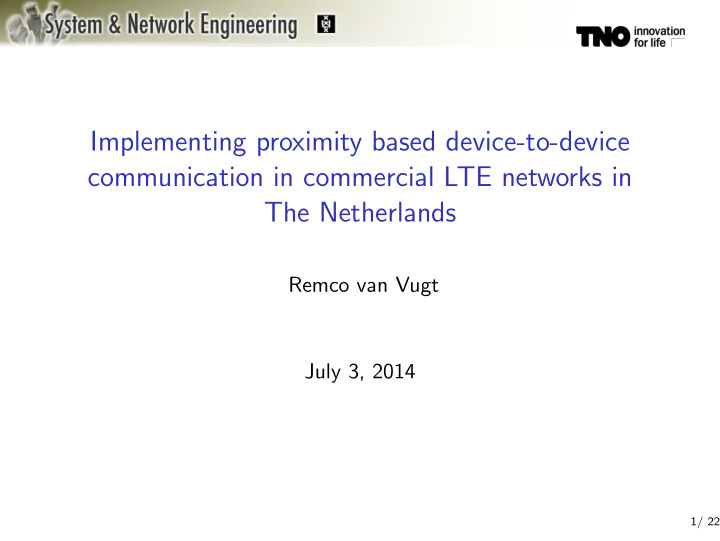



Implementing proximity based device-to-device communication in commercial LTE networks in The Netherlands Remco van Vugt July 3, 2014 1/ 22
Agenda ◮ Introduction ◮ What? ◮ Why? ◮ When? ◮ Research ◮ Use cases ◮ Results ◮ Implementation options ◮ Conclusion ◮ Questions 2/ 22
Introduction (”What?”) ◮ Proximity based services (ProSe) ◮ Device-2-Device Communication (D2D) 3/ 22
Introduction (”Why?”) ◮ More efficient spectrum use towards 5G ◮ Opens new possibilities for smartphone users ◮ Generating revenue for operators 4/ 22
Introduction (”Why?”) (2) ◮ Social networking (who is nearby?) ◮ Advertising ◮ Intelligent traffic / parking systems ◮ Network offloading ◮ Public safety 5/ 22
Introduction (”When?”) ◮ Currently being standardized by 3GPP ◮ 3GPP Release 12 includes public safety (December 2014) ◮ Release 13 scheduled for March 2016 6/ 22
Research ”What are the organizational and technical requirements for enabling proximity based services based on device to device communication on- and between the commercial LTE network operators in the Netherlands?” ◮ Limited to literature study ◮ Based on two use cases ◮ Focus on inter-operator scenario 7/ 22
Use case: advertising ◮ Local business communicating daily offers ◮ Local restaurant communicating todays menu ◮ Cinema wanting to sell last empty seats ◮ ... 8/ 22
Use case: social networking ◮ See who of your friends is nearby ◮ Find people to share a taxi ride ◮ ... 9/ 22
Radio communication ◮ Licensed spectrum ◮ Network assisted ◮ Autonomous ◮ Unlicensed spectrum ◮ Network assisted ◮ Autonomous 10/ 22
Challenges ◮ Inter-operator usage ◮ Battery consumption ◮ Interference ◮ Quality of service ◮ Up-front investment 11/ 22
Challenges (1): Inter-operator usage Imagine KPN customer, using ProSe / D2D to discover a Vodafone customer ◮ KPN customer transmits on spectrum resources belonging to Vodafone? ◮ Vodafone customer listens on KPN spectrum resources? ◮ Communication over dedicated spectrum? ◮ Communication out of band (e.g. bluetooth)? 12/ 22
Challenges (2): Battery consumption ◮ Main issue when using OTT service ◮ Operators can add value on this point 13/ 22
Challenges (3): Interference ◮ Issue on inband communication ◮ Can be avoided by network assistance (coordination) ◮ Can be avoided by dedicated spectrum 14/ 22
Challenges (4): Quality of Service ◮ Issue on outband communication ◮ Main item to add value for operators 15/ 22
Challenges (5): Investment up-front ◮ Infrastructure ◮ Research and development ◮ Spectrum resources 16/ 22
Summary: implementation options ◮ Licensed non-dedicated spectrum ◮ Unlicensed spectrum ◮ Licensed dedicated spectrum ◮ Network (EPC) based discovery 17/ 22
Summary: implementation options (2) ◮ Network (EPC) based discovery: step-up and two-step approach ◮ Preliminary vendor support ◮ Could improve efficiency ◮ Using LTE radio in non-dedicated licensed spectrum ◮ Value adding ◮ Opens up D2D communication 18/ 22
Requirements 19/ 22
Requirements (2) ◮ Authorization for discovery ◮ Discovery of nearby UEs ◮ Authorization for identity ◮ Identity lookup ◮ Authorization for D2D communication ◮ Transport of user-plane data for D2D communication 1 ◮ Reservation of resources 2 1 Depends on use case 2 Depends on implementation model chosen 20/ 22
Conclusion ◮ Promising technique, first signs of industry take-up visible ◮ Operators: get organized! ◮ Exchange peering model? ◮ Working group to be established, as part of GSMA network 2020? ◮ More research needed on commercial models, privacy and (radio) protocols 21/ 22
Questions? 22/ 22
Recommend
More recommend